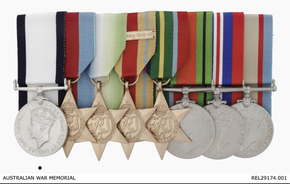GREEN, Clarence Reginald
| Service Number: | 416212 |
|---|---|
| Enlisted: | 24 April 1941 |
| Last Rank: | Flight Lieutenant |
| Last Unit: | Not yet discovered |
| Born: | Tweedvale, SA, 23 April 1918 |
| Home Town: | Not yet discovered |
| Schooling: | Not yet discovered |
| Occupation: | Not yet discovered |
| Memorials: |
World War 2 Service
| 24 Apr 1941: | Enlisted Adelaide | |
|---|---|---|
| 24 Apr 1941: | Enlisted Royal Australian Air Force, Flight Lieutenant, 416212 | |
| 1 Jul 1947: | Discharged | |
| Date unknown: | Honoured Conspicuous Gallantry Medal |
Help us honour Clarence Reginald Green's service by contributing information, stories, and images so that they can be preserved for future generations.
Add my storyBiography contributed by Tim Hanna
From Wartime, 6 July 2023 by Bryce Abraham
In the morning of 8 March 1943, Flight Sergeant Clarence (Reg) Green and his crew in Beaufort A9-181 took off from Milne Bay and flew north-west along the Papuan coast. They were detailed with an anti-submarine patrol for a merchant convoy headed to Buna. Just south of Oro Bay, the convoy was attacked by a formation of nine Japanese bombers and thirteen fighters. The flash of an explosion caught Green’s eye as the bombers sank the SS Jacob. He watched in horror as three fighters peeled off to strafe survivors in the water. Although outgunned and vastly outnumbered, Green banked his Beaufort into a steep turn and manoeuvred to intercept the fighters. He attacked with “such daring and skill” that the fighters broke off the strafing. He continued to patrol between the fighters and sailors until the Japanese aircraft left the scene. Praised for his “extremely courageous & gallant” conduct, Green was the first Australian to be awarded the Conspicuous Gallantry Medal (Flying).
Only ten Conspicuous Gallantry Medals (CGM) were awarded to Australian airmen during the Second World War. It was one of the rarest awards in the Imperial system of British honours. The medal was established in November 1942 to bridge the gap for non-commissioned airmen between the Victoria Cross and the Distinguished Flying Medal. The absence of an award between the two had been questioned by senior officers in the Air Ministry as early as 1940, when recommendations for awards first began trickling in. Not until August 1942 did the Air Council (the governing body of the Royal Air Force) propose that a new medal be created. Following considerable discussion – and some curious proposals as to the name and design of the new award – an existing naval decoration was appropriated instead. The original CGM had been created in 1855, during the Crimean War, to recognise the heroic conduct of naval ratings. In 1940, eligibility for the medal was extended to non-commissioned airmen attached to the Royal Navy’s Fleet Air Arm. So when the Air Council could not agree on the specifics of a new award, they instead swapped the white ribbon of the naval CGM for one of sky blue to create the CGM (Flying). This new medal, the Air Ministry advised, would recognise “conspicuous gallantry in air operations”.










